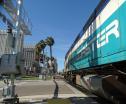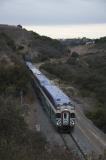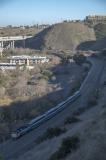
| Home | Open Account | Help | 300 users online |
|
Member Login
Discussion
Media SharingHostingLibrarySite Info |
Passenger Trains > Looking back at Coaster's F40's and Old San DiegoDate: 09/21/21 14:04 Looking back at Coaster's F40's and Old San Diego Author: suvart Coaster commuter service between San Diego and Oceanside has been operating under the jurisdiction of the North County Transit District since 1995, when service launched with 5 MK built F40PHM-2C’s numbered 2101-2105. They spent the next 25 years as the core of NCTD’s fleet. If you lived in San Diego during this time, your foaming variety was basically going to be a question of which F40 you saw. As you can image, it was easy to end up complacent and not pay them any mind. They’d been there for years and would be there for the foreseeable future. Then, in 2018, NCTD announced the purchase of 5 replacement Chargers (5001-5005) for the F40’s. Purchased with grant money, the blocks of the F40’s had to be rendered inoperable when the Chargers were placed into service. About a year before the Charger delivery, I decided I should make an effort to photograph the F40’s before their retirement. Unfortunately, between life and COVID (which decimated Coaster’s schedule & the number of sets in service), I didn’t take nearly as many pictures as I had wanted to. Nonetheless, attached below is a collection of pictures I did manage to take, supplemented with photos from the Pacific Southwest Railway Museum library.
While a northbound passenger’s trip starts at Santa Fe depot, many Coaster crew’s journeys start further south in the former SD&AE yard. The SD&AE was the SP’s way into San Diego until 1976, when Hurricane Kathleen wiped out the line. SP sold the SD&AE to the Metropolitan Transit Development Board, later the Metropolitan Transit System (MTS), who saw a chance to build a commuter operation on the cheap (prior to this, expensive BART-like systems were being considered). The mainline to TJ and branch to El Cajon became light rail “trolley” corridors, and the yard was rebuilt into a maintenance facility. Historically, downtown San Diego was an industrial and military port district, infamous for all the seediness associated with that. As the industrial presence declined and the seediness increased, San Diego leaders began to think about “revitalization”. In the early 1990’s, the trolley was expanded north to Santa Fe Depot and Old Town following the SD&AE/ATSF ROW. Several stops were established and in conjunction dozens of hotels, shops, clubs, and high density “5 over 1” apartments were constructed in the surrounding areas. Since then, downtown has been completely transformed into a glitzy tourist and transplant destination. This is one of the earliest modern instances I know of where a light rail project was used as a vehicle for real estate development. Certainly not the last! 1-3: Old San Diego C. 1965
   Date: 09/21/21 14:09 Re: Looking back at Coaster's F40's and Old San Diego Author: suvart 4-6: “Revitalized” San Diego C. 2016
   Date: 09/21/21 14:11 Re: Looking back at Coaster's F40's and Old San Diego Author: suvart 7-9: More revitalization
7. An F40 heads north to join the afternoon commute rush C. 2017. Image taken looking north from 5th st. Everything from the ROW to the surroundings is completely unrecognizable when compared to image 3. Union St (where image 3 was taken) is in the distance on the right but is obscured by apartments and trees. 8. Up at the depot, ATSF 344 waits to take the last of the ATSF San Diegans north on April 30th, 1971. 9. 2101 waits to take the last F40 powered coaster set north out of Santa Fe Depot on February 5th, 2021. The yard and freight shed in the other image had long dispappeared by the time Coaster service started, and the skyline has been properly "revitalized" in the 25 years since then. Edited 1 time(s). Last edit at 09/21/21 14:47 by suvart.    Date: 09/21/21 14:13 Re: Looking back at Coaster's F40's and Old San Diego Author: suvart 10-11: Santa Fe depot Contin.
Edited 1 time(s). Last edit at 09/21/21 14:14 by suvart.   Date: 09/21/21 14:20 Re: Looking back at Coaster's F40's and Old San Diego Author: suvart 12-14: Northbound
   Date: 09/21/21 14:23 Re: Looking back at Coaster's F40's and Old San Diego Author: suvart 15-17: Rose Canyon
15. A Santa Fe San Diegan passes through Rose Canyon in the 1960's. 16. An F40 shoves a SB Coaster through recently completed double track at the same location c. July 2020. 17. 2102 north knocks down CP Rose in 2016. CP rose was the first phase of the double tracking project. A CTC controlled crossover, it replaced CP Elvira a mile south. Elvira was a Santa Fe WW2 era capacity improvement project, moving the mainline off the floor of Rose Canyon and installing double track up to Miramar. Elvira was supposedly the name of a well-liked daughter of the Miramar (then Linda Vista) station agent. 1944 date nails can still be found in many of the ties through here.    Date: 09/21/21 14:26 Re: Looking back at Coaster's F40's and Old San Diego Author: suvart 18-23: Miramar
Miramar is the summit of a rather steep section of grade just RR west (north) of San Diego. In the steam days it was a helper district, and until the advent of DPU’s Santa Fe/BNSF had tonnage limits on trains over the hill to prevent stringlines. The west side of the hill (compass north) is the most brutal. A 2.2% ruling grade, it winds its way through Sorrento Valley. The area was undeveloped until the late 1980’s, when office parks began to dot the hills. Still, this is one of the more “scenic” stretches of the old 4th district not yet totally lost to development. 18. An evening San Diegan drifts downgrade into Sorrento Valley, having just crested Miramar summit. 19. 2103 leads an evening Coaster north toward Sorrento Valley at the same location some 50+ years later (c. 2021). 20. 2104 shoves a SB toward the summit on a smokey grey day during fire season 2020.    Date: 09/21/21 14:33 Re: Looking back at Coaster's F40's and Old San Diego Author: suvart 21. Cab car 2304, shoved by an F40, heads south for San Diego (c. 2021)
22. 2102 rounds a rather dramatic curve midway down the hill, headed north for Sorrento. (c. 2018) 23. 2104 south approaches CP Scripps on another hazy day during fire season 2020. Scripps was a 2014 era project to expand Sorrento siding. Now, double track stretches from CP Scripps below the 805 to CP Torrey in the Torrey Pines marsh. Edited 1 time(s). Last edit at 09/21/21 14:37 by suvart.    Date: 09/21/21 14:37 Re: Looking back at Coaster's F40's and Old San Diego Author: suvart 24-29: Sorrento
The modern-day Sorrento is completely developed, a major freeway artery and home to a biotech hub that makes Sorrento Valley one of the busiest Coaster stops. 24/25. A NB coaster w/ F59 3002 and F40 2105 passes below the I-805 c. 2018. It wasn’t uncommon to see a double headed train. Usually, one was providing HEP and the other was doing the heavy lifting. 26. 2101 passes an office park as it approaches it’s station stop in Sorrento Valley c. 2020. For those of you with the book Southland, page 145 has a has a picture of a San Diegan at this location when the office park was someone’s ranch house.    Date: 09/21/21 14:39 Re: Looking back at Coaster's F40's and Old San Diego Author: suvart 27. 2101 glides off of Miramar hill and into the mouth of Sorrento Valley in 2020.
28. 2103 gets ready to battle Miramar as it accelerates out of a station stop in Sorrento. Everything visible in this shot was once the grounds of a massive year-round Kumeyaay village, known as Ystagua. 29. A glimpse of the future. Northbound test train c. Jan 2021    Date: 09/21/21 14:44 Re: Looking back at Coaster's F40's and Old San Diego Author: suvart 30-35: Torrey Pines
Torrey Pines is where the line finally makes a dash for the coast, ending up on the bluffs of Del Mar. This is actually the second alignment of the railroad. As built, the railroad climbed the hills around the marsh and went down what is today Camino Del Mar through the middle of Del Mar. The line was moved onto the bluffs along the coast in the early 1900’s at the request of Del Martians, who wanted the train out of their town. Their descendants keep that spirit alive today, demanding the current alignment be removed and new alignments be routed up the I-5 rather than through Del Mar. 30. 2103 knocks down CP Torrey and prepares to stop at Sorrento Valley. 31. An F40 shoves a SB across the marsh. 32. 2103 rolls north through the marsh c. 2019. These concrete bridges replaced the original wood bridges in 2014, which by some accounts were simply floating in the mud by that point.    Date: 09/21/21 14:48 Re: Looking back at Coaster's F40's and Old San Diego Author: suvart 33/34. 2101 north glides across the marsh c. 2021.
35. A SB F59 powered Coaster passes through the marsh. With the arrival of the Chargers the F59’s have become standby power.    Date: 09/21/21 14:50 Re: Looking back at Coaster's F40's and Old San Diego Author: PE-717 The first photo is interesting because the Hi-Level next to the heavyweight car is a 1954 prototype Hi-Level of which there were only 2. Also note the Hi-Level lounge car in the consist. Ray
Posted from iPhone Date: 09/21/21 15:00 Re: Looking back at Coaster's F40's and Old San Diego Author: suvart 35+ North County
The “Surfline” doesn’t actually get near the surf until it reaches Del Mar. After that it passes through multiple costal communities on the way to Oceanside, never straying very far from the water. Now, "northern costal beach communities" roughly translates to “expensive, trafficy tourist traps” in native San Diegan, so I usually avoid these areas and unfortunately didn’t take many pictures as a result. 35/36. 2102 rolls through the Del Mar bluffs during the summer of 2016. As far as images go they aren't that great and as far as summer crowds go this isn't that bad, but it's illustritave of why trespasser strikes are such a contenious issue through here. 37. 2104 rolls by the Del Mar station and siding. The station was used through the mid 90's, until San Diegan service began to increase and Coaster service began. The station needed parking and ADA upgrades, and the story goes the Del Martians themselves blocked that from happening and joined the polictical push to make Solana Beach the main station for beachgoers and fairground users instead. Today the station is a private office Edited 1 time(s). Last edit at 09/21/21 15:02 by suvart.    Date: 09/21/21 15:08 Re: Looking back at Coaster's F40's and Old San Diego Author: suvart 38. 2102 North passes CP Carfiff in 2017. At the time it was still single track from Carfiff to Solona Beach, today the work just getting started in the image has been completed, and it's double track all the way to Solana.
29. 2101 North rolls through Carfiff. The F40's have been sitting in Stuart Mesa retired for several months now, and are the property of the Pacific Southwest Railway Muesum. Planning is underway for their eventual movement to Campo and restoration. Donations to the project are much appreciated and can be made here: https://www.psrm.org/donate/ Edited 1 time(s). Last edit at 09/21/21 15:12 by suvart.   Date: 09/21/21 15:25 Re: Looking back at Coaster's F40's and Old San Diego Author: SGillings Nice series. You caught one of the rebuilt 51 PA units and the 51 PB unit in picture 15. I've only seen pictures of the two 51 PAs and the 51 PB operating as a trio after rebuild.
Steve Date: 09/21/21 16:24 Re: Looking back at Coaster's F40's and Old San Diego Author: ProAmtrak Nice pics, love the Then and Now pics the best!
Date: 09/21/21 18:46 Re: Looking back at Coaster's F40's and Old San Diego Author: atsf121 Really enjoyed this series, especially the Then & No comparisons. I normally think of San Diego as a Santa Fe town, it’s easy to forget the SP presence as it was gone by the time I first visited. Need to get back, love the San Diego area.
Nathan Posted from iPhone Date: 09/21/21 18:51 Re: Looking back at Coaster's F40's and Old San Diego Author: dwatry Wow love this set! I spent a lot of time in North County (parents lived in Carlsbad), so really appreciate these photos.
Date: 09/21/21 20:34 Re: Looking back at Coaster's F40's and Old San Diego Author: WP17 Love the "Fly PSA" sign in the first photo.
WP17 |